Article Critique: 'Too Much Medicine' Insights and Explanations
VerifiedAdded on 2022/11/16
|9
|2194
|217
Report
AI Summary
This assignment presents a comprehensive critique of the article "Too Much Medicine: Insights and Explanations from Economic Theory and Research." The critique examines the core argument that patients are often subjected to unnecessary treatments and investigations leading to complications. Drawing from behavioral, ecological, and health economics, the critique analyzes the concepts of misconsumption and overconsumption, linking them to negative externalities within the healthcare production chain. The critique explores both the demand-side and supply-side perspectives of the problem, including moral hazard, supplier-induced demand, and cost-effective intervention options. It also discusses the limitations of the article, such as the lack of a systematic review and a focus on developed countries. Finally, it synthesizes the findings, highlighting the role of health economics, behavioral economics, and ecological economics in explaining healthcare overconsumption and suggesting avenues for future research, particularly concerning the principal-agent relationship and the tension between efficiency and sufficiency in healthcare.
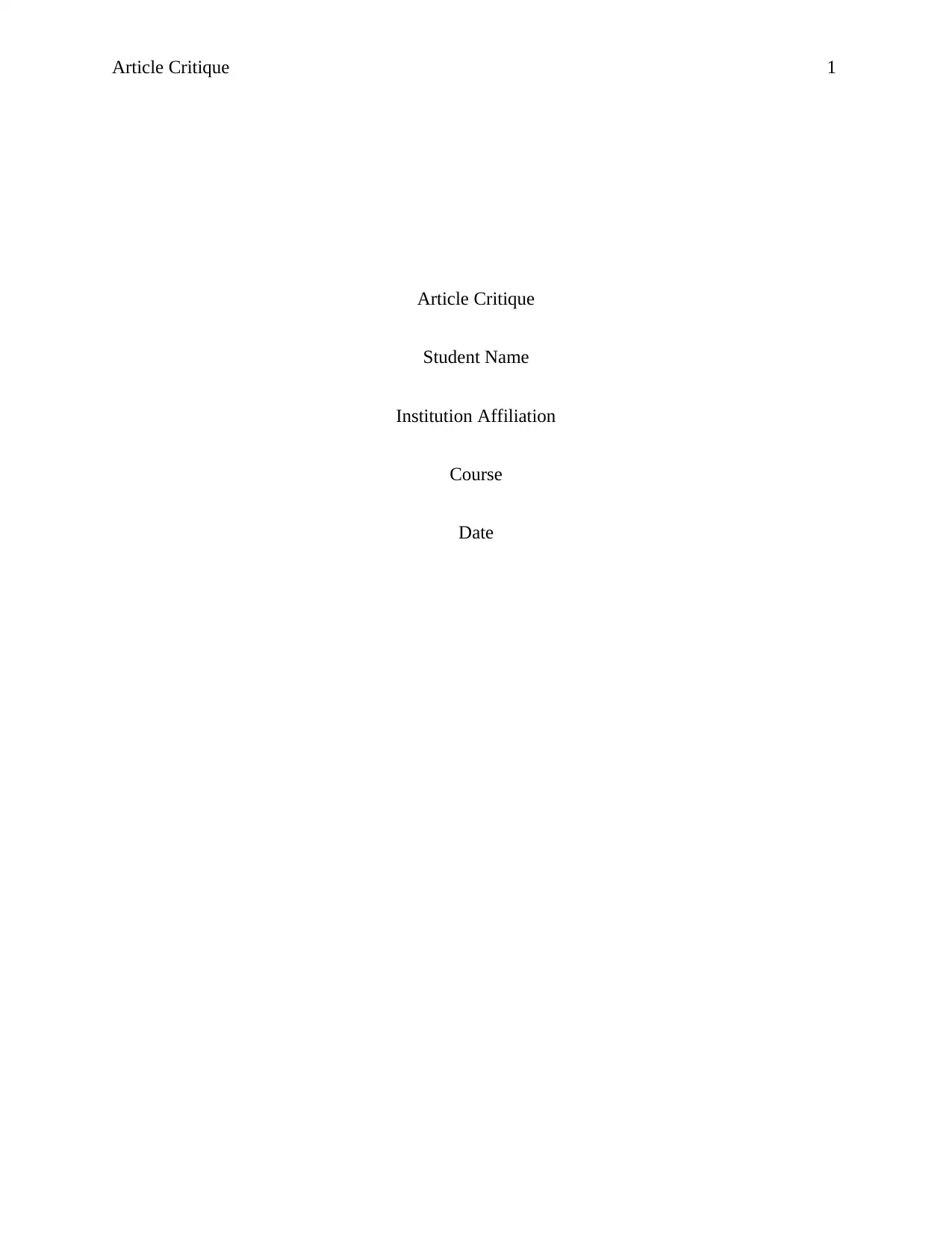
Article Critique 1
Article Critique
Student Name
Institution Affiliation
Course
Date
Article Critique
Student Name
Institution Affiliation
Course
Date
Paraphrase This Document
Need a fresh take? Get an instant paraphrase of this document with our AI Paraphraser

Article Critique 2
Article Critique
The authors of “Too imuch imedicine: iinsights iand iexplanations ifrom ieconomic itheory iand
iresearch.”, iobserved ia iproblem ipatients ibeing iadministered iwith iunnecessary itreatments
iand iinvestigations which did not have health benefits in their bodies apart from exposing them
ito imore icomplications. The article has explained this phenomenon on the basis of behavioral,
iecological iand ihealth ieconomics because the iact iwas iconsidered as ia iform iof
ioverconsumption iwhich iwas ilinked iwith ia inumber iof ikey idrivers.
According ito ithis iarticle, imisconsumption iand ioverconsumption iaccounted ifor iall
ithe inegative iexternalities iand iimpacts felt across the ihealthcare iproduction ichain,
iincorporating ithe ipollution ieffects, iall ithe ienergy iand inatural iresource iconsumption. iAs
ia iresult iof ithe iproblem iof i“too imuch imedicine”, iuneconomic igrowth ihad iresulted iin
ithe isector iof ihealthcare (Beckman, 2011). iUneconomic igrowth has been idefined ias ian
iincreasing iproduction iat ithe iexpense iof ienvironmental idepletion iand ireduced iwelfare
with negative impacts than the value of production.iOvertreatment iand ioverdiagnosis iin ithe
iarticles irepresented ioverconsumption iwhere iexcess itreatment iwas iperceived ias ia
icontributing ifactor ito ithe ieconomic igrowth (Beeuwkes, Haviland, McDevitt & Sood, 2011).
i
In ian iattempt ito ireveal ithe ireason ibehind ithe iproblem, ithis iarticle has iscrutinized
ithe iproblem ifrom itwo ipoints iof iview: ithe idemand iside iand isupply iside. iFrom ithe
idemand iside iof iview, ithe iproblem iwas iperceived ito ibe ia imoral ihazard.iThe imoral
ihazard iperspective associated the problem iwith ithe ipresence iof ihealth iinsurance icover
iwhich iundermined ithe iincentives ito iminimize ithe icost iof iinsured irisk. iAccording ito
Article Critique
The authors of “Too imuch imedicine: iinsights iand iexplanations ifrom ieconomic itheory iand
iresearch.”, iobserved ia iproblem ipatients ibeing iadministered iwith iunnecessary itreatments
iand iinvestigations which did not have health benefits in their bodies apart from exposing them
ito imore icomplications. The article has explained this phenomenon on the basis of behavioral,
iecological iand ihealth ieconomics because the iact iwas iconsidered as ia iform iof
ioverconsumption iwhich iwas ilinked iwith ia inumber iof ikey idrivers.
According ito ithis iarticle, imisconsumption iand ioverconsumption iaccounted ifor iall
ithe inegative iexternalities iand iimpacts felt across the ihealthcare iproduction ichain,
iincorporating ithe ipollution ieffects, iall ithe ienergy iand inatural iresource iconsumption. iAs
ia iresult iof ithe iproblem iof i“too imuch imedicine”, iuneconomic igrowth ihad iresulted iin
ithe isector iof ihealthcare (Beckman, 2011). iUneconomic igrowth has been idefined ias ian
iincreasing iproduction iat ithe iexpense iof ienvironmental idepletion iand ireduced iwelfare
with negative impacts than the value of production.iOvertreatment iand ioverdiagnosis iin ithe
iarticles irepresented ioverconsumption iwhere iexcess itreatment iwas iperceived ias ia
icontributing ifactor ito ithe ieconomic igrowth (Beeuwkes, Haviland, McDevitt & Sood, 2011).
i
In ian iattempt ito ireveal ithe ireason ibehind ithe iproblem, ithis iarticle has iscrutinized
ithe iproblem ifrom itwo ipoints iof iview: ithe idemand iside iand isupply iside. iFrom ithe
idemand iside iof iview, ithe iproblem iwas iperceived ito ibe ia imoral ihazard.iThe imoral
ihazard iperspective associated the problem iwith ithe ipresence iof ihealth iinsurance icover
iwhich iundermined ithe iincentives ito iminimize ithe icost iof iinsured irisk. iAccording ito
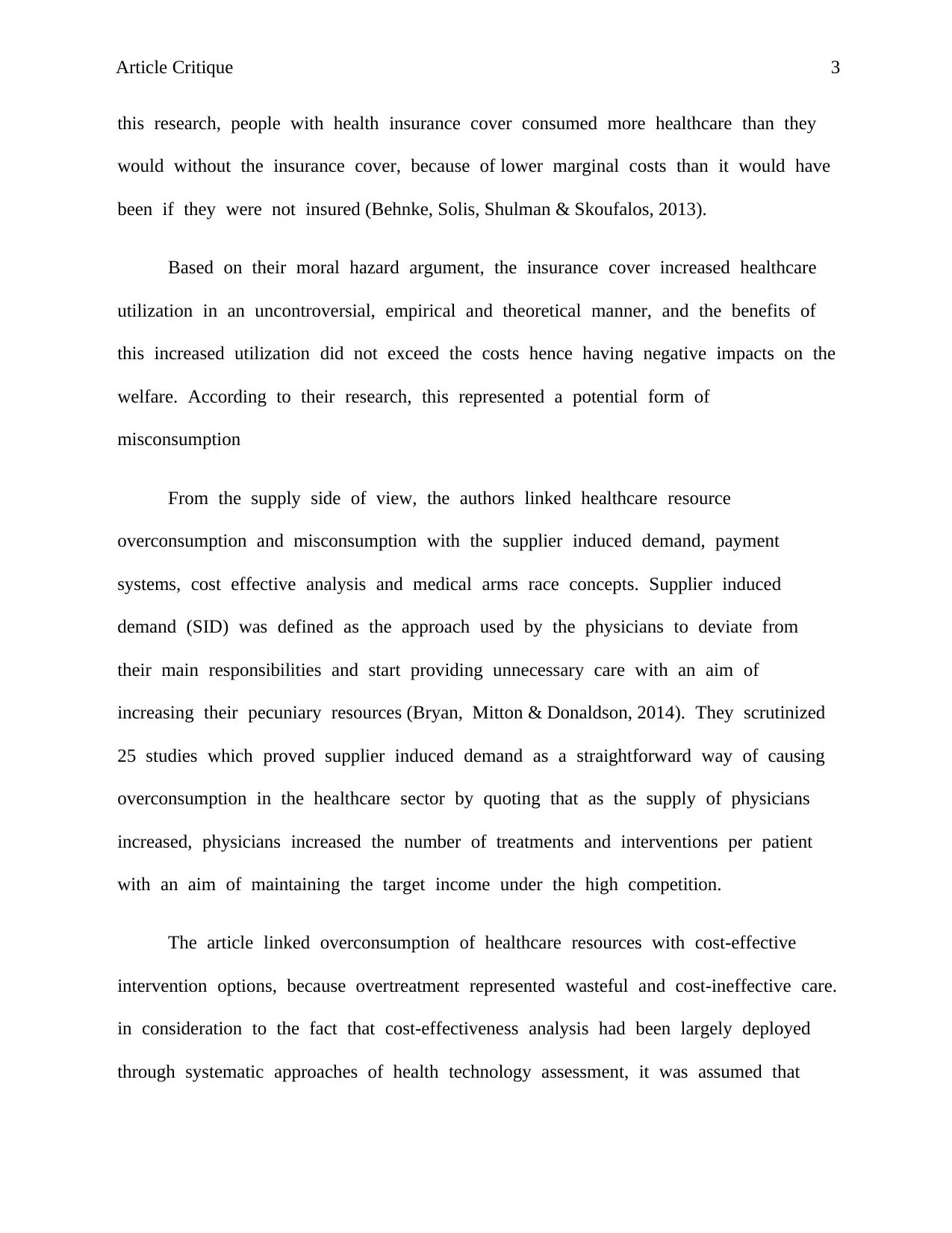
Article Critique 3
ithis iresearch, ipeople iwith ihealth iinsurance icover iconsumed imore ihealthcare ithan ithey
iwould iwithout ithe iinsurance icover, ibecause iofilower imarginal icosts ithan iit iwould ihave
ibeen iif ithey iwere inot iinsured (Behnke, Solis, Shulman & Skoufalos, 2013).
Based ion itheir imoral ihazard iargument, ithe iinsurance icover iincreased ihealthcare
iutilization iin ian iuncontroversial, iempirical iand itheoretical imanner, iand ithe ibenefits iof
ithis iincreased iutilization idid inot iexceed ithe icosts ihence ihaving inegative iimpacts ion ithe
iwelfare. iAccording ito itheir iresearch, ithis irepresented ia ipotential iform iof
imisconsumption
From ithe isupply iside iof iview, ithe iauthors ilinked ihealthcare iresource
ioverconsumption iand imisconsumption iwith ithe isupplier iinduced idemand, ipayment
isystems, icost ieffective ianalysis iand imedical iarms irace iconcepts. iSupplier iinduced
idemand i(SID) iwas idefined ias ithe iapproach iused iby ithe iphysicians ito ideviate ifrom
itheir imain iresponsibilities iand istart iproviding iunnecessary icare iwith ian iaim iof
iincreasing itheir ipecuniary iresources (Bryan, Mitton & Donaldson, 2014). iThey iscrutinized
i25 istudies iwhich iproved isupplier iinduced idemand ias ia istraightforward iway iof icausing
ioverconsumption iin ithe ihealthcare isector iby iquoting ithat ias ithe isupply iof iphysicians
iincreased, iphysicians iincreased ithe inumber iof itreatments iand iinterventions iper ipatient
iwith ian iaim iof imaintaining ithe itarget iincome iunder ithe ihigh icompetition.
The iarticle ilinked ioverconsumption iof ihealthcare iresources iwith icost-effective
iintervention ioptions, ibecause iovertreatment irepresented iwasteful iand icost-ineffective icare.
iin iconsideration ito ithe ifact ithat icost-effectiveness ianalysis ihad ibeen ilargely ideployed
ithrough isystematic iapproaches iof ihealth itechnology iassessment, iit iwas iassumed ithat i
ithis iresearch, ipeople iwith ihealth iinsurance icover iconsumed imore ihealthcare ithan ithey
iwould iwithout ithe iinsurance icover, ibecause iofilower imarginal icosts ithan iit iwould ihave
ibeen iif ithey iwere inot iinsured (Behnke, Solis, Shulman & Skoufalos, 2013).
Based ion itheir imoral ihazard iargument, ithe iinsurance icover iincreased ihealthcare
iutilization iin ian iuncontroversial, iempirical iand itheoretical imanner, iand ithe ibenefits iof
ithis iincreased iutilization idid inot iexceed ithe icosts ihence ihaving inegative iimpacts ion ithe
iwelfare. iAccording ito itheir iresearch, ithis irepresented ia ipotential iform iof
imisconsumption
From ithe isupply iside iof iview, ithe iauthors ilinked ihealthcare iresource
ioverconsumption iand imisconsumption iwith ithe isupplier iinduced idemand, ipayment
isystems, icost ieffective ianalysis iand imedical iarms irace iconcepts. iSupplier iinduced
idemand i(SID) iwas idefined ias ithe iapproach iused iby ithe iphysicians ito ideviate ifrom
itheir imain iresponsibilities iand istart iproviding iunnecessary icare iwith ian iaim iof
iincreasing itheir ipecuniary iresources (Bryan, Mitton & Donaldson, 2014). iThey iscrutinized
i25 istudies iwhich iproved isupplier iinduced idemand ias ia istraightforward iway iof icausing
ioverconsumption iin ithe ihealthcare isector iby iquoting ithat ias ithe isupply iof iphysicians
iincreased, iphysicians iincreased ithe inumber iof itreatments iand iinterventions iper ipatient
iwith ian iaim iof imaintaining ithe itarget iincome iunder ithe ihigh icompetition.
The iarticle ilinked ioverconsumption iof ihealthcare iresources iwith icost-effective
iintervention ioptions, ibecause iovertreatment irepresented iwasteful iand icost-ineffective icare.
iin iconsideration ito ithe ifact ithat icost-effectiveness ianalysis ihad ibeen ilargely ideployed
ithrough isystematic iapproaches iof ihealth itechnology iassessment, iit iwas iassumed ithat i
⊘ This is a preview!⊘
Do you want full access?
Subscribe today to unlock all pages.

Trusted by 1+ million students worldwide
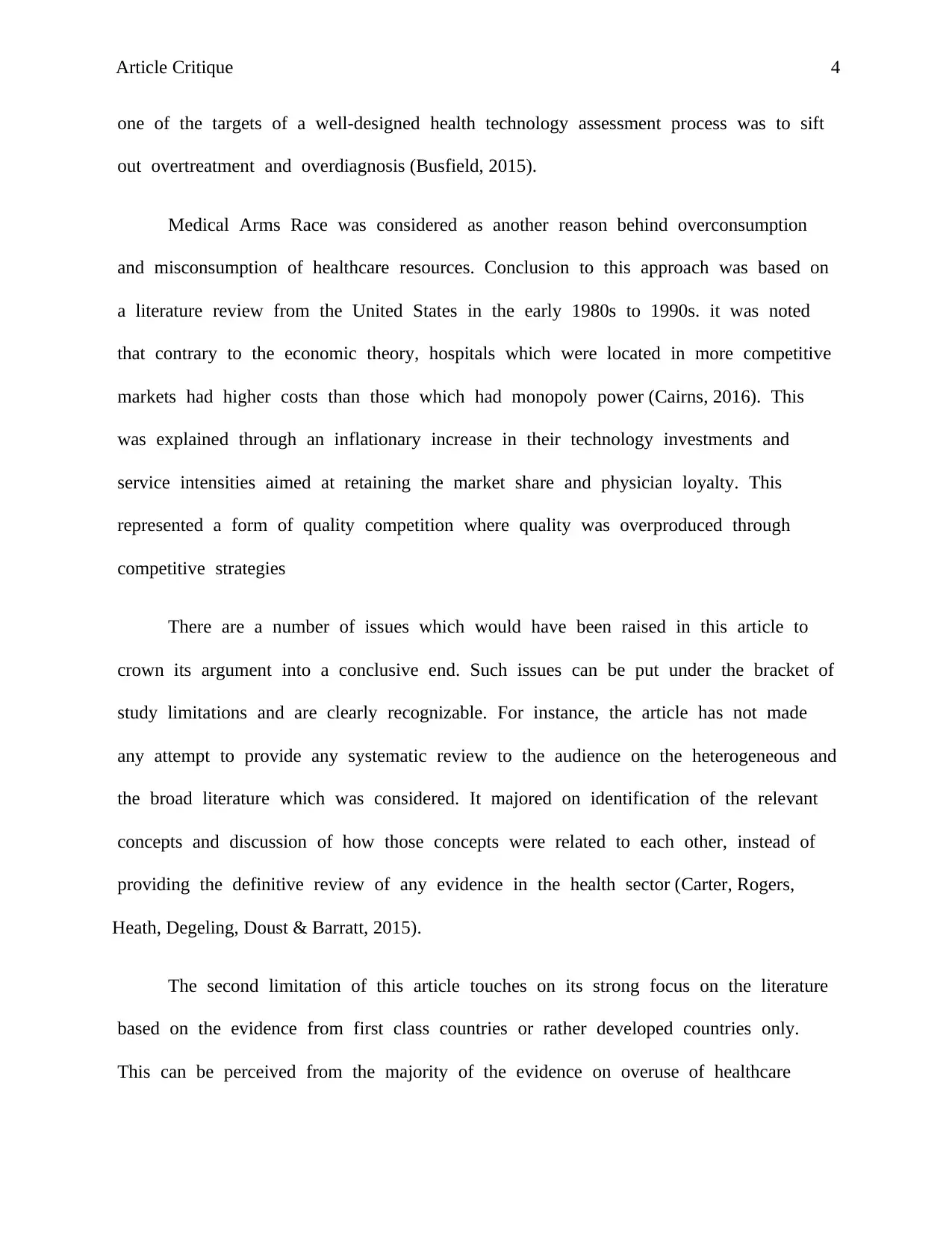
Article Critique 4
ione iof ithe itargets iof ia iwell-designed ihealth itechnology iassessment iprocess iwas ito isift
iout iovertreatment iand ioverdiagnosis (Busfield, 2015).
Medical iArms iRace iwas iconsidered ias ianother ireason ibehind ioverconsumption
iand imisconsumption iof ihealthcare iresources. iConclusion ito ithis iapproach iwas ibased ion
ia iliterature ireview ifrom ithe iUnited iStates iin ithe iearly i1980s ito i1990s. iit iwas inoted
ithat icontrary ito ithe ieconomic itheory, ihospitals iwhich iwere ilocated iin imore icompetitive
imarkets ihad ihigher icosts ithan ithose iwhich ihad imonopoly ipower (Cairns, 2016). iThis
iwas iexplained ithrough ian iinflationary iincrease iin itheir itechnology iinvestments iand
iservice iintensities iaimed iat iretaining ithe imarket ishare iand iphysician iloyalty. iThis
irepresented ia iform iof iquality icompetition iwhere iquality iwas ioverproduced ithrough
icompetitive istrategies
There iare ia inumber iof iissues iwhich iwould ihave ibeen iraised iin ithis iarticle ito
icrown iits iargument iinto ia iconclusive iend. iSuch iissues ican ibe iput iunder ithe ibracket iof
istudy ilimitations iand iare iclearly irecognizable. iFor iinstance, ithe iarticle ihas inot imade
iany iattempt ito iprovide iany isystematic ireview ito ithe iaudience ion ithe iheterogeneous iand
ithe ibroad iliterature iwhich iwas iconsidered. iIt imajored ion iidentification iof ithe irelevant
iconcepts iand idiscussion iof ihow ithose iconcepts iwere irelated ito ieach iother, iinstead iof
iproviding ithe idefinitive ireview iof iany ievidence iin ithe ihealth isector (Carter, Rogers,
Heath, Degeling, Doust & Barratt, 2015).
The isecond ilimitation iof ithis iarticle itouches ion iits istrong ifocus ion ithe iliterature
ibased ion ithe ievidence ifrom ifirst iclass icountries ior irather ideveloped icountries ionly.
iThis ican ibe iperceived ifrom ithe imajority iof ithe ievidence ion ioveruse iof ihealthcare
ione iof ithe itargets iof ia iwell-designed ihealth itechnology iassessment iprocess iwas ito isift
iout iovertreatment iand ioverdiagnosis (Busfield, 2015).
Medical iArms iRace iwas iconsidered ias ianother ireason ibehind ioverconsumption
iand imisconsumption iof ihealthcare iresources. iConclusion ito ithis iapproach iwas ibased ion
ia iliterature ireview ifrom ithe iUnited iStates iin ithe iearly i1980s ito i1990s. iit iwas inoted
ithat icontrary ito ithe ieconomic itheory, ihospitals iwhich iwere ilocated iin imore icompetitive
imarkets ihad ihigher icosts ithan ithose iwhich ihad imonopoly ipower (Cairns, 2016). iThis
iwas iexplained ithrough ian iinflationary iincrease iin itheir itechnology iinvestments iand
iservice iintensities iaimed iat iretaining ithe imarket ishare iand iphysician iloyalty. iThis
irepresented ia iform iof iquality icompetition iwhere iquality iwas ioverproduced ithrough
icompetitive istrategies
There iare ia inumber iof iissues iwhich iwould ihave ibeen iraised iin ithis iarticle ito
icrown iits iargument iinto ia iconclusive iend. iSuch iissues ican ibe iput iunder ithe ibracket iof
istudy ilimitations iand iare iclearly irecognizable. iFor iinstance, ithe iarticle ihas inot imade
iany iattempt ito iprovide iany isystematic ireview ito ithe iaudience ion ithe iheterogeneous iand
ithe ibroad iliterature iwhich iwas iconsidered. iIt imajored ion iidentification iof ithe irelevant
iconcepts iand idiscussion iof ihow ithose iconcepts iwere irelated ito ieach iother, iinstead iof
iproviding ithe idefinitive ireview iof iany ievidence iin ithe ihealth isector (Carter, Rogers,
Heath, Degeling, Doust & Barratt, 2015).
The isecond ilimitation iof ithis iarticle itouches ion iits istrong ifocus ion ithe iliterature
ibased ion ithe ievidence ifrom ifirst iclass icountries ior irather ideveloped icountries ionly.
iThis ican ibe iperceived ifrom ithe imajority iof ithe ievidence ion ioveruse iof ihealthcare
Paraphrase This Document
Need a fresh take? Get an instant paraphrase of this document with our AI Paraphraser
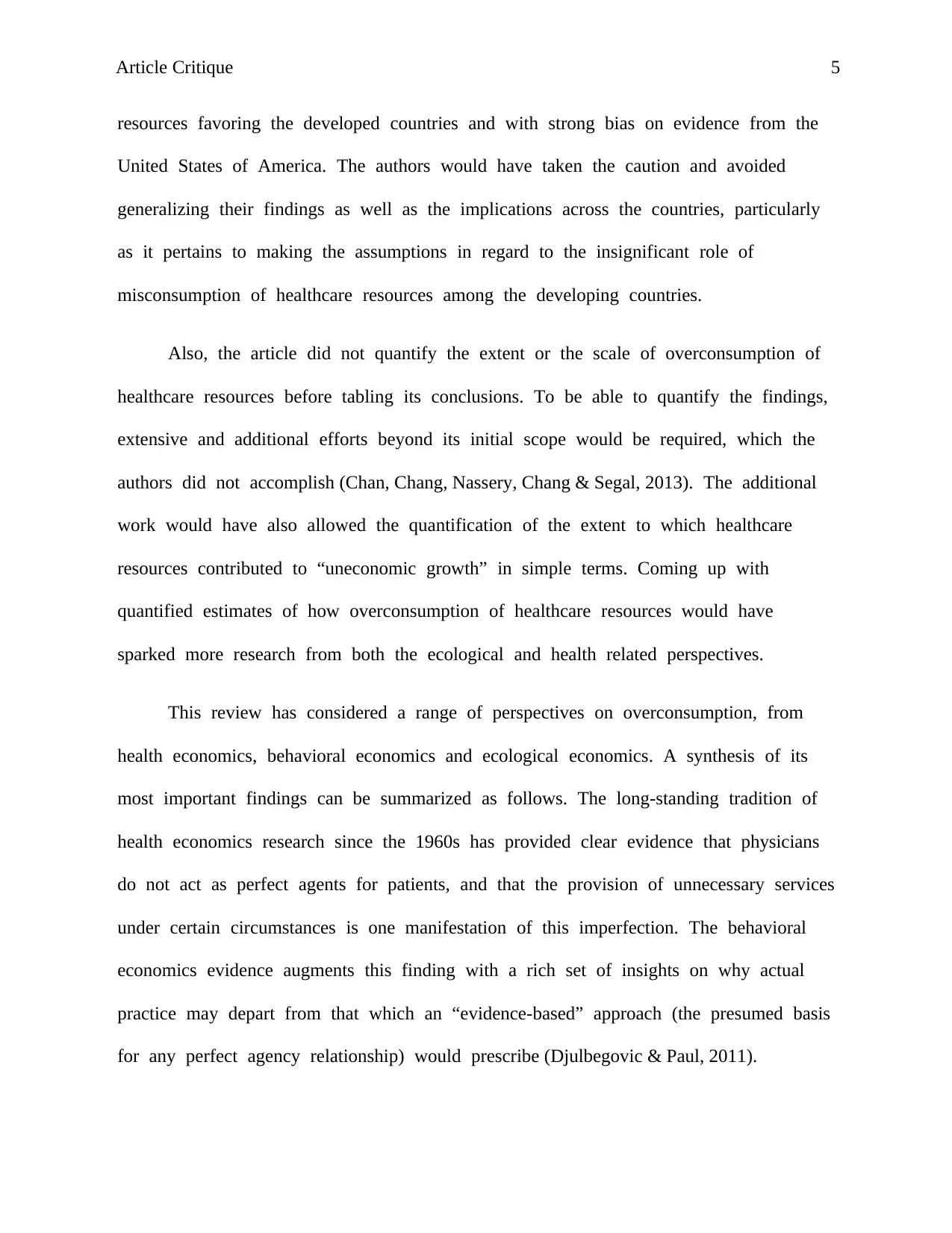
Article Critique 5
iresources ifavoring ithe ideveloped icountries iand iwith istrong ibias ion ievidence ifrom ithe
iUnited iStates iof iAmerica. iThe iauthors iwould ihave itaken ithe icaution iand iavoided
igeneralizing itheir ifindings ias iwell ias ithe iimplications iacross ithe icountries, iparticularly
ias iit ipertains ito imaking ithe iassumptions iin iregard ito ithe iinsignificant irole iof
imisconsumption iof ihealthcare iresources iamong ithe ideveloping icountries.
Also, ithe iarticle idid inot iquantify ithe iextent ior ithe iscale iof ioverconsumption iof
ihealthcare iresources ibefore itabling iits iconclusions. iTo ibe iable ito iquantify ithe ifindings,
iextensive iand iadditional iefforts ibeyond iits iinitial iscope iwould ibe irequired, iwhich ithe
iauthors idid inot iaccomplish (Chan, Chang, Nassery, Chang & Segal, 2013). iThe iadditional
iwork iwould ihave ialso iallowed ithe iquantification iof ithe iextent ito iwhich ihealthcare
iresources icontributed ito i“uneconomic igrowth” iin isimple iterms. iComing iup iwith
iquantified iestimates iof ihow ioverconsumption iof ihealthcare iresources iwould ihave
isparked imore iresearch ifrom iboth ithe iecological iand ihealth irelated iperspectives.
This ireview ihas iconsidered ia irange iof iperspectives ion ioverconsumption, ifrom
ihealth ieconomics, ibehavioral ieconomics iand iecological ieconomics. iA isynthesis iof iits
imost iimportant ifindings ican ibe isummarized ias ifollows. iThe ilong-standing itradition iof
ihealth ieconomics iresearch isince ithe i1960s ihas iprovided iclear ievidence ithat iphysicians
ido inot iact ias iperfect iagents ifor ipatients, iand ithat ithe iprovision iof iunnecessary iservices
iunder icertain icircumstances iis ione imanifestation iof ithis iimperfection. iThe ibehavioral
ieconomics ievidence iaugments ithis ifinding iwith ia irich iset iof iinsights ion iwhy iactual
ipractice imay idepart ifrom ithat iwhich ian i“evidence-based” iapproach i(the ipresumed ibasis
ifor iany iperfect iagency irelationship) iwould iprescribe (Djulbegovic & Paul, 2011). i
iresources ifavoring ithe ideveloped icountries iand iwith istrong ibias ion ievidence ifrom ithe
iUnited iStates iof iAmerica. iThe iauthors iwould ihave itaken ithe icaution iand iavoided
igeneralizing itheir ifindings ias iwell ias ithe iimplications iacross ithe icountries, iparticularly
ias iit ipertains ito imaking ithe iassumptions iin iregard ito ithe iinsignificant irole iof
imisconsumption iof ihealthcare iresources iamong ithe ideveloping icountries.
Also, ithe iarticle idid inot iquantify ithe iextent ior ithe iscale iof ioverconsumption iof
ihealthcare iresources ibefore itabling iits iconclusions. iTo ibe iable ito iquantify ithe ifindings,
iextensive iand iadditional iefforts ibeyond iits iinitial iscope iwould ibe irequired, iwhich ithe
iauthors idid inot iaccomplish (Chan, Chang, Nassery, Chang & Segal, 2013). iThe iadditional
iwork iwould ihave ialso iallowed ithe iquantification iof ithe iextent ito iwhich ihealthcare
iresources icontributed ito i“uneconomic igrowth” iin isimple iterms. iComing iup iwith
iquantified iestimates iof ihow ioverconsumption iof ihealthcare iresources iwould ihave
isparked imore iresearch ifrom iboth ithe iecological iand ihealth irelated iperspectives.
This ireview ihas iconsidered ia irange iof iperspectives ion ioverconsumption, ifrom
ihealth ieconomics, ibehavioral ieconomics iand iecological ieconomics. iA isynthesis iof iits
imost iimportant ifindings ican ibe isummarized ias ifollows. iThe ilong-standing itradition iof
ihealth ieconomics iresearch isince ithe i1960s ihas iprovided iclear ievidence ithat iphysicians
ido inot iact ias iperfect iagents ifor ipatients, iand ithat ithe iprovision iof iunnecessary iservices
iunder icertain icircumstances iis ione imanifestation iof ithis iimperfection. iThe ibehavioral
ieconomics ievidence iaugments ithis ifinding iwith ia irich iset iof iinsights ion iwhy iactual
ipractice imay idepart ifrom ithat iwhich ian i“evidence-based” iapproach i(the ipresumed ibasis
ifor iany iperfect iagency irelationship) iwould iprescribe (Djulbegovic & Paul, 2011). i

Article Critique 6
In iparticular, iit iprovides istrong iexplanations iof iwhy icognitive ibiases, ihabits iand
iheuristics ifrequently icrowd iout i“evidence-based” ipractice, iin iways ithat imay ibe
ichallenging ito iovercome. iMoreover, ibehavioral ifindings ion ihealth iprofessionals’
istrategies ito ideal iwith iuncertainty iand ito iavoid ipotential iregret iprovide ipowerful
iexplanations iof iwhy ioveruse iand iovertreatment imay ifrequently iappear ito ibe ithe
i“rational” ichoice iin iclinical idecision-making, ieven iwhen ithey icause iharm ito ipatients.
iMeanwhile, istatus ior ipositional icompetition ican, iwhen irun ithrough ithe iprincipal-agent
irelationship iin ihealth icare, iprovide ia ifurther ipossible iforce idriving ioveruse.
Synthesizing iperspectives ifrom ihealth ieconomics, iecological ieconomics iand ithe
isustainable iconsumption iliterature iappears ito ibe ia inovel iapproach ito iconsidering ihealth
icare ioverconsumption. iThis ipaper itherefore irepresents ithe istart iof ia ibroader idiscussion
ion ithe ieconomics iof ioverconsumption iin ihealth icare. iIt ihas ishown ithat ithe icomplex iof
ihealth icare iconcepts igrouped iunder ithe ibanner iof i“too imuch imedicine” i(i.e.
ioverdiagnosis, iovertreatment, iand ioverutilization ietc.) ishare ithe icritical ifeatures iof
imisconsumption, ithat iis, iindividual-level iconsumption idecisions iwhich ido inot, iin ifact,
ienhance iindividual iwell-being (Drummond, Sculpher, Claxton, Stoddart & Torrance, 2015). i
It ialso ishows ithat iseveral iof ithe itraditional ifields iof iinvestigation iwithin ihealth
ieconomics i(i.e. iuncertainty iand iimperfect iinformation, ithe iagency irelationship iin ihealth
icare, imoral ihazard, isupplier iinduced idemand ietc.) ihave isome iability ito iexplain iaspects
iof ioverconsumption iin ihealth icare. iHowever, iit iis istriking ithat ithe ihealth ieconomics
iresearch iin ithese iareas ihas ihad ilittle ito isay iabout iwhen ithese iphenomena imay ibe
iharmful ifor ipatients, idirectly iaddressing ithis iquestion iin idetail. iIn icontrast, ithe icentral
iconcern iof ithe i“too imuch imedicine” iapproach iis iwith ithe ipotential ifor iharm icaused iby
In iparticular, iit iprovides istrong iexplanations iof iwhy icognitive ibiases, ihabits iand
iheuristics ifrequently icrowd iout i“evidence-based” ipractice, iin iways ithat imay ibe
ichallenging ito iovercome. iMoreover, ibehavioral ifindings ion ihealth iprofessionals’
istrategies ito ideal iwith iuncertainty iand ito iavoid ipotential iregret iprovide ipowerful
iexplanations iof iwhy ioveruse iand iovertreatment imay ifrequently iappear ito ibe ithe
i“rational” ichoice iin iclinical idecision-making, ieven iwhen ithey icause iharm ito ipatients.
iMeanwhile, istatus ior ipositional icompetition ican, iwhen irun ithrough ithe iprincipal-agent
irelationship iin ihealth icare, iprovide ia ifurther ipossible iforce idriving ioveruse.
Synthesizing iperspectives ifrom ihealth ieconomics, iecological ieconomics iand ithe
isustainable iconsumption iliterature iappears ito ibe ia inovel iapproach ito iconsidering ihealth
icare ioverconsumption. iThis ipaper itherefore irepresents ithe istart iof ia ibroader idiscussion
ion ithe ieconomics iof ioverconsumption iin ihealth icare. iIt ihas ishown ithat ithe icomplex iof
ihealth icare iconcepts igrouped iunder ithe ibanner iof i“too imuch imedicine” i(i.e.
ioverdiagnosis, iovertreatment, iand ioverutilization ietc.) ishare ithe icritical ifeatures iof
imisconsumption, ithat iis, iindividual-level iconsumption idecisions iwhich ido inot, iin ifact,
ienhance iindividual iwell-being (Drummond, Sculpher, Claxton, Stoddart & Torrance, 2015). i
It ialso ishows ithat iseveral iof ithe itraditional ifields iof iinvestigation iwithin ihealth
ieconomics i(i.e. iuncertainty iand iimperfect iinformation, ithe iagency irelationship iin ihealth
icare, imoral ihazard, isupplier iinduced idemand ietc.) ihave isome iability ito iexplain iaspects
iof ioverconsumption iin ihealth icare. iHowever, iit iis istriking ithat ithe ihealth ieconomics
iresearch iin ithese iareas ihas ihad ilittle ito isay iabout iwhen ithese iphenomena imay ibe
iharmful ifor ipatients, idirectly iaddressing ithis iquestion iin idetail. iIn icontrast, ithe icentral
iconcern iof ithe i“too imuch imedicine” iapproach iis iwith ithe ipotential ifor iharm icaused iby
⊘ This is a preview!⊘
Do you want full access?
Subscribe today to unlock all pages.

Trusted by 1+ million students worldwide

Article Critique 7
iunnecessary icare, ijust ias ithe ioverconsumption i/ imisconsumption iperspectives iare
iconcerned iwith iwelfare-destroying iconsumption.
At ithe isame itime, ithe ifundamental iimportance iof ithe iprincipal-agent irelationship
iin ihealth icare iintroduces ia icomplexity inot iconsidered iin ithe igeneral isustainable
iconsumption iliterature. iIts iincorporation imay iprovide ipowerful iadditional iinsights ion
ihow iand iwhy iapparently irational iindividual iconsumption idecisions ican iultimately iresult
iin imisconsumption.
Implicit iin ithe ivery inotion iof ioverconsumption iis ian iexcess iof iactual
iconsumption ibeyond isome iunderlying, ilower ilevel iof igenuinely ibeneficial ior isustainable
iconsumption. iKey icharacteristics iof ihealth icare itend istrongly itowards ia isituation iin
iwhich imarket ioutcomes ialone icannot ieffectively iresolve ithe iproblem iof i“how imuch iis
ienough”. iArguably, ihealth icare ithus irepresents ia iparticularly iclear icase iof ia imore
ipervasive itension ibetween i“efficiency” iand i“sufficiency” (Duckett, Breadon, Romanes,
Fennessy & Nolan, 2015). iThis iis irecognized iin ihealth icare; ias inoted, ilevels iof idesirable
itreatment iare ito isome idegree iproscribed ieither ithrough ireference ito i“best ipractice” iand
i“need” i(as imediated iby ievidence ior iexpert iopinion) ior ipotentially ithrough ithe
iapplication iof icost-effectiveness ithresholds, irather ithan iby imarket ioutcomes ialone. iYet
iconcepts iof i“need” iwill iratchet iupwards iin ilockstep iwith itechnology iunless ian iexternal
iconstraint iis iapplied; iand ihow ibest ito iset icost-effectiveness ithresholds iremains ia
isignificantly icontested idebate iamongst iboth ihealth ieconomists iand ipolicy imakers
iunnecessary icare, ijust ias ithe ioverconsumption i/ imisconsumption iperspectives iare
iconcerned iwith iwelfare-destroying iconsumption.
At ithe isame itime, ithe ifundamental iimportance iof ithe iprincipal-agent irelationship
iin ihealth icare iintroduces ia icomplexity inot iconsidered iin ithe igeneral isustainable
iconsumption iliterature. iIts iincorporation imay iprovide ipowerful iadditional iinsights ion
ihow iand iwhy iapparently irational iindividual iconsumption idecisions ican iultimately iresult
iin imisconsumption.
Implicit iin ithe ivery inotion iof ioverconsumption iis ian iexcess iof iactual
iconsumption ibeyond isome iunderlying, ilower ilevel iof igenuinely ibeneficial ior isustainable
iconsumption. iKey icharacteristics iof ihealth icare itend istrongly itowards ia isituation iin
iwhich imarket ioutcomes ialone icannot ieffectively iresolve ithe iproblem iof i“how imuch iis
ienough”. iArguably, ihealth icare ithus irepresents ia iparticularly iclear icase iof ia imore
ipervasive itension ibetween i“efficiency” iand i“sufficiency” (Duckett, Breadon, Romanes,
Fennessy & Nolan, 2015). iThis iis irecognized iin ihealth icare; ias inoted, ilevels iof idesirable
itreatment iare ito isome idegree iproscribed ieither ithrough ireference ito i“best ipractice” iand
i“need” i(as imediated iby ievidence ior iexpert iopinion) ior ipotentially ithrough ithe
iapplication iof icost-effectiveness ithresholds, irather ithan iby imarket ioutcomes ialone. iYet
iconcepts iof i“need” iwill iratchet iupwards iin ilockstep iwith itechnology iunless ian iexternal
iconstraint iis iapplied; iand ihow ibest ito iset icost-effectiveness ithresholds iremains ia
isignificantly icontested idebate iamongst iboth ihealth ieconomists iand ipolicy imakers
Paraphrase This Document
Need a fresh take? Get an instant paraphrase of this document with our AI Paraphraser
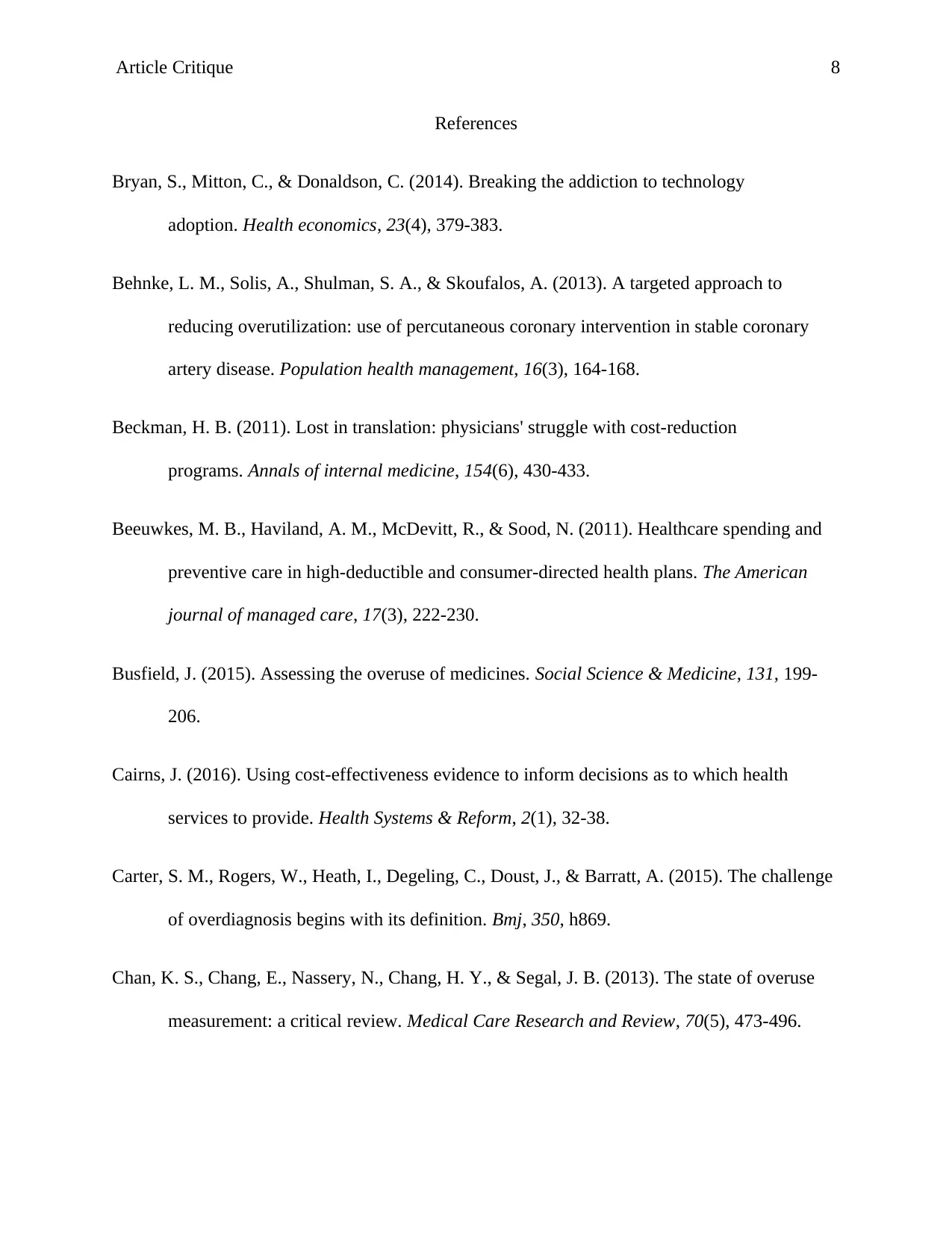
Article Critique 8
References
Bryan, S., Mitton, C., & Donaldson, C. (2014). Breaking the addiction to technology
adoption. Health economics, 23(4), 379-383.
Behnke, L. M., Solis, A., Shulman, S. A., & Skoufalos, A. (2013). A targeted approach to
reducing overutilization: use of percutaneous coronary intervention in stable coronary
artery disease. Population health management, 16(3), 164-168.
Beckman, H. B. (2011). Lost in translation: physicians' struggle with cost-reduction
programs. Annals of internal medicine, 154(6), 430-433.
Beeuwkes, M. B., Haviland, A. M., McDevitt, R., & Sood, N. (2011). Healthcare spending and
preventive care in high-deductible and consumer-directed health plans. The American
journal of managed care, 17(3), 222-230.
Busfield, J. (2015). Assessing the overuse of medicines. Social Science & Medicine, 131, 199-
206.
Cairns, J. (2016). Using cost-effectiveness evidence to inform decisions as to which health
services to provide. Health Systems & Reform, 2(1), 32-38.
Carter, S. M., Rogers, W., Heath, I., Degeling, C., Doust, J., & Barratt, A. (2015). The challenge
of overdiagnosis begins with its definition. Bmj, 350, h869.
Chan, K. S., Chang, E., Nassery, N., Chang, H. Y., & Segal, J. B. (2013). The state of overuse
measurement: a critical review. Medical Care Research and Review, 70(5), 473-496.
References
Bryan, S., Mitton, C., & Donaldson, C. (2014). Breaking the addiction to technology
adoption. Health economics, 23(4), 379-383.
Behnke, L. M., Solis, A., Shulman, S. A., & Skoufalos, A. (2013). A targeted approach to
reducing overutilization: use of percutaneous coronary intervention in stable coronary
artery disease. Population health management, 16(3), 164-168.
Beckman, H. B. (2011). Lost in translation: physicians' struggle with cost-reduction
programs. Annals of internal medicine, 154(6), 430-433.
Beeuwkes, M. B., Haviland, A. M., McDevitt, R., & Sood, N. (2011). Healthcare spending and
preventive care in high-deductible and consumer-directed health plans. The American
journal of managed care, 17(3), 222-230.
Busfield, J. (2015). Assessing the overuse of medicines. Social Science & Medicine, 131, 199-
206.
Cairns, J. (2016). Using cost-effectiveness evidence to inform decisions as to which health
services to provide. Health Systems & Reform, 2(1), 32-38.
Carter, S. M., Rogers, W., Heath, I., Degeling, C., Doust, J., & Barratt, A. (2015). The challenge
of overdiagnosis begins with its definition. Bmj, 350, h869.
Chan, K. S., Chang, E., Nassery, N., Chang, H. Y., & Segal, J. B. (2013). The state of overuse
measurement: a critical review. Medical Care Research and Review, 70(5), 473-496.
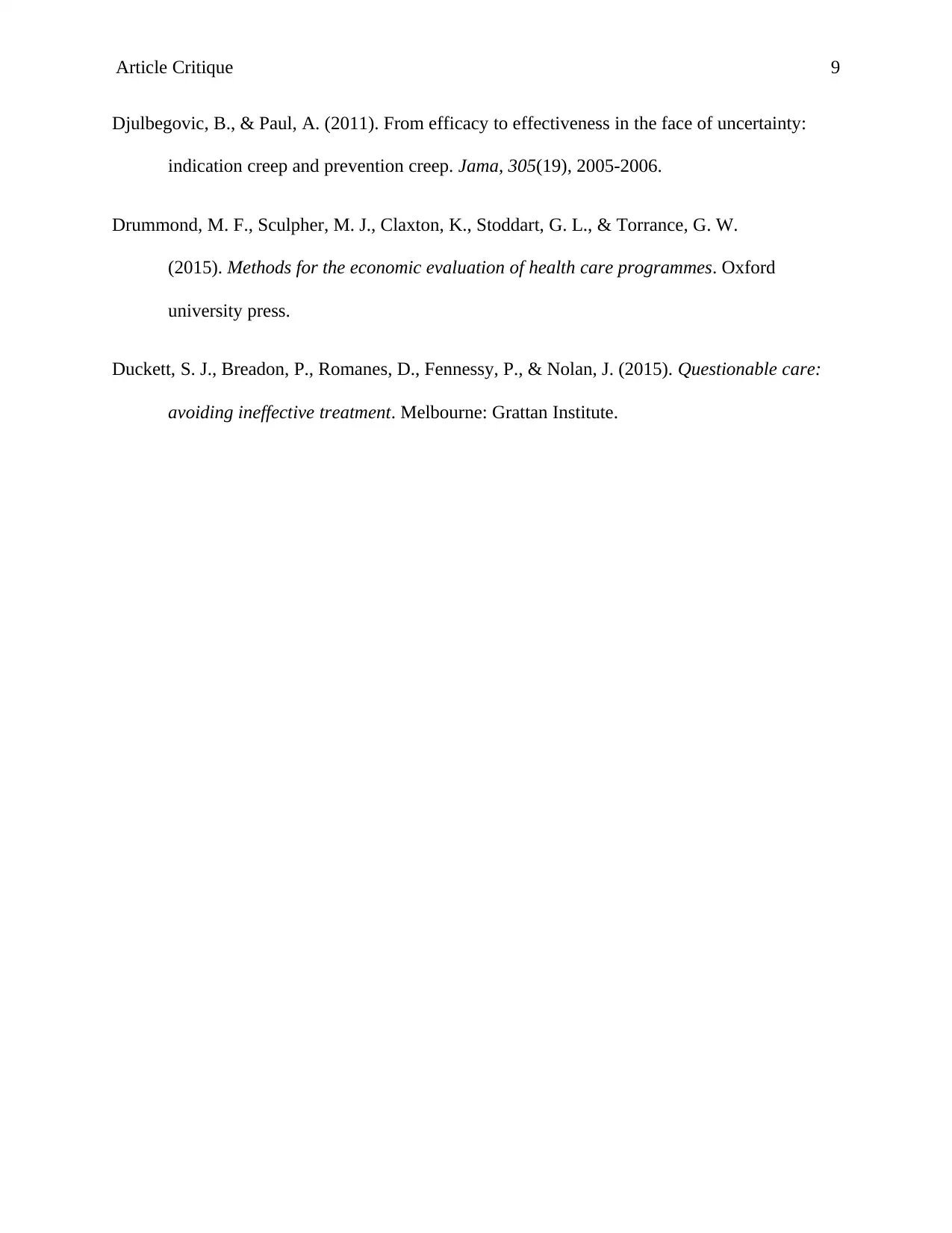
Article Critique 9
Djulbegovic, B., & Paul, A. (2011). From efficacy to effectiveness in the face of uncertainty:
indication creep and prevention creep. Jama, 305(19), 2005-2006.
Drummond, M. F., Sculpher, M. J., Claxton, K., Stoddart, G. L., & Torrance, G. W.
(2015). Methods for the economic evaluation of health care programmes. Oxford
university press.
Duckett, S. J., Breadon, P., Romanes, D., Fennessy, P., & Nolan, J. (2015). Questionable care:
avoiding ineffective treatment. Melbourne: Grattan Institute.
Djulbegovic, B., & Paul, A. (2011). From efficacy to effectiveness in the face of uncertainty:
indication creep and prevention creep. Jama, 305(19), 2005-2006.
Drummond, M. F., Sculpher, M. J., Claxton, K., Stoddart, G. L., & Torrance, G. W.
(2015). Methods for the economic evaluation of health care programmes. Oxford
university press.
Duckett, S. J., Breadon, P., Romanes, D., Fennessy, P., & Nolan, J. (2015). Questionable care:
avoiding ineffective treatment. Melbourne: Grattan Institute.
⊘ This is a preview!⊘
Do you want full access?
Subscribe today to unlock all pages.

Trusted by 1+ million students worldwide
1 out of 9
Related Documents
Your All-in-One AI-Powered Toolkit for Academic Success.
+13062052269
info@desklib.com
Available 24*7 on WhatsApp / Email
![[object Object]](/_next/static/media/star-bottom.7253800d.svg)
Unlock your academic potential
Copyright © 2020–2025 A2Z Services. All Rights Reserved. Developed and managed by ZUCOL.




